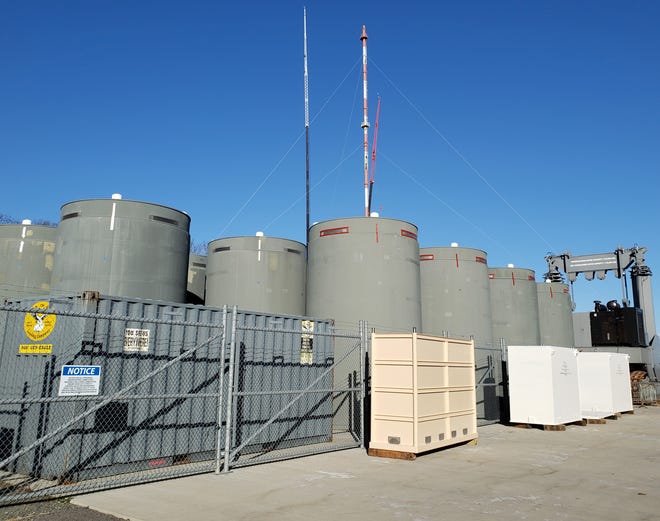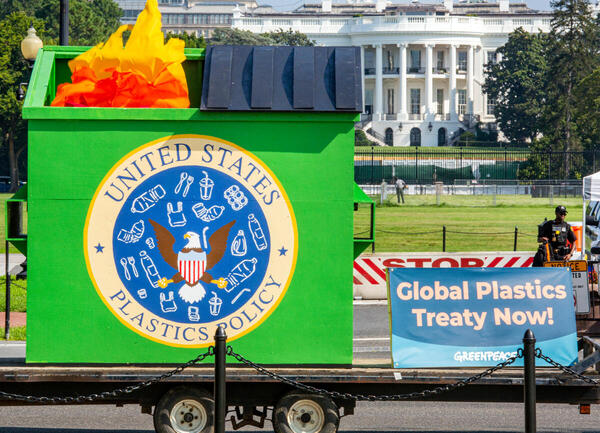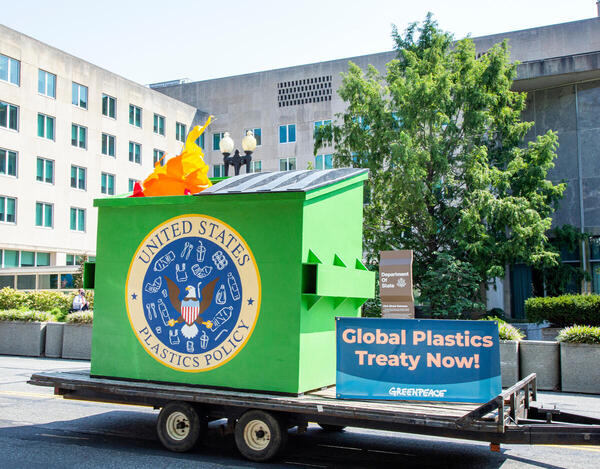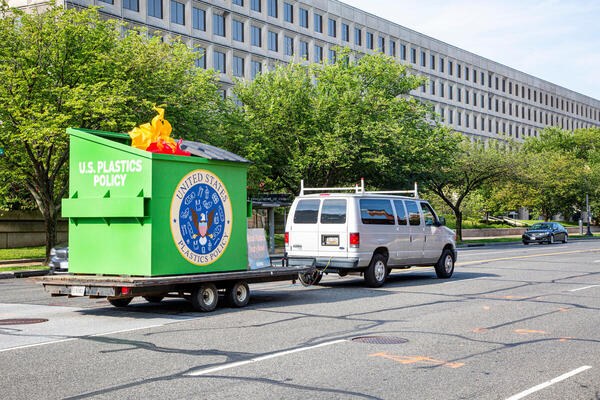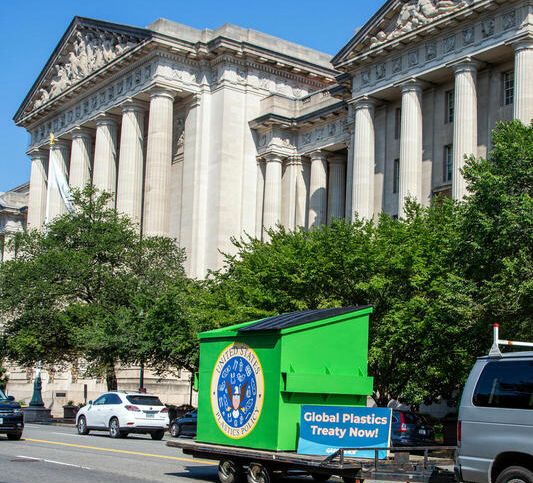In the midst of new mine development and renewed production of nuclear weapons, some organizers believe that a world without “weapons of mass extinction” is possible
On Wednesday, Dec. 8, the House Judiciary committee held a mark-up for the RECA Amendments Act, new legislation that will offer continued redress to a wider array of communities affected by radiation exposure from Cold War-era uranium mining and nuclear testing. The bill passed favorably to the House despite eight votes in opposition—Congressman Jim Jordan went so far as to lament that the legislation would cost over $2.8 billion to taxpayers, asserting that the government shouldn’t be responsible for uranium miners employed after 1971 and that the science “simply does not support the expansion of the program under this bill.” Jordan ultimately implored that “we should take a little more time.”
Jordan’s statement paints the fight for RECA as hasty and relatively recent. But those who have helped draft and advocate for the legislation since its initial passage in 1990—former miners, downwinders, members of the Navajo Nation—have arguably lost more time than legislators could imagine. For over half a century, their communities have lived with the damage from radiation exposure to both their health and the environment as a result of the U.S. government’s reluctance to share knowledge of those dangers with impacted communities and the general public. No financial amount can fully compensate for the lives lost, compromised health, and stolen potential futures free from constant struggle.
Interestingly, Jordan’s claim that the science doesn’t support RECA expansion is based on a 2005 study conducted by the National Research Council Board on Radiation Effects Research that recommended RECA use a “probability of causation” model to determine eligibility of applicants, which RECA advocates argue will result in far fewer claimants being eligible for compensation. RECA currently evaluates whether or not a claimant is entitled to compensation based on their geographic location at the time of their presumed exposure to radiation, and the version of the Amendments Act awaiting passage still bases claimants’ eligibility based on geographic location.
Should the Amendments Act pass, new relief would be offered to those who are struggling with radiation damage to their bodies and homes but were left out of the original bill for a variety of reasons. Clearly, the government’s pursuit of nuclear material in the Cold War came at incalculable human, financial, and environmental costs. Yet the construction of new mines, the production of nuclear weapon materials, and slow-moving cleanup efforts for abandoned uranium mines, continue to pose a threat to communities throughout the Southwest and beyond. Despite the proven risks and damage done to miners and their families, downwinders, Indigenous communities, and the land itself, the U.S. government is choosing to continue a deadly cycle, the consequences of which are borne by some of the most vulnerable people in the country.
While activists and advocates haven’t given up, whether or not those in power are paying attention to the human and environmental costs of those lessons still remains to be seen. Retroactive payments for contaminated land, damaged health, further harm to Indigenous communities, and loss of life shouldn’t be acceptable costs in the name of “national security,” especially not when forward-thinking efforts can prevent such harm from being inflicted in the first place. The dangerous legacy of Cold War-era mining will only continue unless the lessons gleaned from the very horrors that required the RECA Amendments Act to be created are heeded in full.
Bulldozing over the lessons of the past
The Cold War may be over, but the need to mine for natural material resources remains, regardless of the risk. In the most recent survey conducted by the Fraser Institute’s Centre for Natural Resource Studies, Nevada was identified as the most attractive region for mining companies based on its geological profile and state policies that were amenable to mining. The state is the site of two major mining projects currently under development focused on the production of critical materials such as vanadium, lithium, and even uranium. Public backlash by nearby Indigenous communities has been fervent, particularly with the damage done to many Navajo communities during the Cold War uranium boom still in recent memory.
In 2017, the Trump administration implored the federal government “to reduce the Nation’s vulnerability to disruptions in the supply of critical minerals”—including vanadium. By June 2020, Trump released an executive order allowing for the fast-tracking of environmental reviews for projects, which enabled federal land managers to launch an expedited permitting process for the Nevada Vanadium Company to establish what will be the first vanadium mine in the U.S. Known as the Gibellini Project, the open-pit mine will sit on 10-square miles in the Battle Mountain region of Nevada, south of Eureka and northeast of Carson City. The mine could begin operations as early as 2024.
The company intends to mine roughly 10 million pounds of vanadium per year, a rare metal often used to strengthen steel, aluminum, and titanium. In addition to job creation—the company projects the development of over 200 new jobs from construction workers to mine employees—the mine would also work to address what Silver Elephant Mining, a Toronto-based mining company, predicts will be a vanadium deficit by the year 2025 due in large part to the popularity of the vanadium redox flow battery used in power plants and electrical grids. Some reported health effects of vanadium exposure primarily for those working in vanadium production have included acute and chronic respiratory illnesses including bronchitis, shortness of breath, and fatigue.
Most concerning for environmental justice advocates however, is Nevada Vanadium Company’s plan to also extract about 50,000 pounds of uranium per year. Nevada-based advocates argue that the company’s intentions to produce uranium, in particular, pose risks that outweigh the benefits of additional jobs, especially the risks that miners, their families, and surrounding communities—including Indigenous communities like the Navajo Nation that are still suffering from the effects of uranium mining in the Cold War—would be assuming. As reported by Prism, radiation exposure from yellowcake mining can have long-lasting and far-reaching health implications for those who work in mines, their loved ones, and the biodiversity of the surrounding region.
The Gibellini Project and other recently proposed mines in other parts of the state exemplify not just how much harm Indigenous communities stand to face but how readily the government moves forward with infrastructure projects despite the concerns of Native communities. These projects sit in a long line of “innovations” used to justify government-sanctioned violence and abuse against Indigenous peoples and their lands. And that same disregard isn’t limited to the Southwest—its shadow extends to new development projects targeting communities of color elsewhere in the country.
“There’s no dollar amount you can pay to heal communities after they’re harmed”
The prevalence and resurgence of mining in the U.S. extends as far east as South Carolina. Unfortunately, so do the production and risk of exposure to nuclear materials. Queen Quet, chieftess of the Gullah Geechee Nation, says that when some members of her community heard about plans to begin plutonium pit production by the Savannah River, they assumed it was a mining operation. It wasn’t. A plutonium pit is the core of a nuclear weapon that enables an explosive chain reaction when detonated. Environmentalists and community leaders are concerned about radiation exposure from plutonium pit production.
“Many people in our community have never before heard of a plutonium pit. Quite naturally, then, they would assume that we’re talking about mining again because we have this onslaught of mines coming up in South Carolina,” Queen Quet said in a June press conference hosted by the South Carolina Environmental Law Project. “[They didn’t realize] this is a nuclear warhead and for it to be created, the plutonium that is utilized is a radioactive material.”
The presence of radioactive material in the area isn’t new—the Savannah River Site, a 310-square-mile nuclear facility in the Sandhills region of South Carolina that is owned by the Department of Energy (DOE), produced tritium and plutonium during the Cold War and began to cease operations after the war’s end. But the damage had been done—by 1989, the site was named an EPA Superfund priority clean-up site due to the presence of about 35 million gallons of leftover radioactive liquid waste. Currently, it stores 11.5 metric tons of plutonium, and advocates worry that new pit production will only increase that inventory and its environmental impact.
The DOE and the National Nuclear Security Administration (NNSA) intend to restart operations at the Savannah River Site in order to produce plutonium pits. This year, the DOE requested $603 million for new pit production in order to achieve their production goal of 80 pits per year by 2030. Fifty of these pits would be produced at the Savannah River Site and 30 at the Los Alamos National Lab in New Mexico. Pit production has become a DOE priority in large part because W87-1s, a newly developed warhead, require new pits. However, at the June press conference Marylia Kelley, executive director and co-founder of TriValley Communities Against a Radioactive Environment, explained that the use of new pits is an “elective” design. Those very weapons, Kelley argued, can operate without new pits, and the push for increased production is not just hasty but also causing an unnecessary threat to the surrounding areas.
In a statement by the South Carolina Environment Law Project (SCELP), the group says that nuclear bomb core production brings “the risk of lethal accidents, fires, radioactive and hazardous waste releases that could affect downstream and downwind communities, and uncertain future radioactive waste disposal that could strand yet more plutonium in South Carolina.” Downwind communities include groups like the Gullah Geechee, an independently and internationally recognized nation comprising roughly 1 million African descendants. The Gullah Geechee Nation stretches from Jacksonville, North Carolina, to Jacksonville, Florida, and includes the Sea Islands and roughly 30 miles inland to the St. Johns River.
“Anything that happens at the Savannah River Plant will end up impacting those that are down the watershed,” said Queen Quet. “So it will reach the Gullah Geechee Nation. It will reach us on the coast and not just by water, but by air.”
This June, SCELP joined the Gullah Geechee Nation, SRS Watch, and other groups in filing a joint legal challenge against the DOE and NNSA, requesting that they complete a programmatic environmental impact statement as required by the National Environmental Policy Act. The statement would require the government to comprehensively assess the environmental consequences of restarting new pit production and would create greater transparency between the government’s plans and the general public. The assessment would also force NNSA and DOE to consider reasonable alternatives posing less harm to the environment and surrounding communities.
“Why is it that the NEPA regulations aren’t being followed?” Queen Quet asked. “Why is it that our community is not now being engaged so that we are well aware of any injustices and negative environmental impacts that will take place? … There’s no dollar amount you can pay to heal communities after they’re harmed.”
Queen Quet’s recognition that true justice hinges not just on redressing past harm but also ensuring that future generations are not further plagued by similar problems is radically different from how the government has approached nuclear testing and weapons development. Some organizers point out that there’s an alternative to simply paying the price after havoc has already been wrought: the abolition of nuclear weapons in their entirety.
Security doesn’t mean nuclear weapons
Marena Blanchard, a Oakland-based organizer and a campaigner with Roots Action, is working alongside Arianna Nason, a Minnesota-based organizer, in a forthcoming coalition-based campaign calling for the abolition of Intercontinental Ballistic Missiles (ICBMs). As part of a larger landscape that makes up the military industrial complex, ICBMs are missiles designed to deliver nuclear warheads, and the U.S. currently has a stock of 400 that are set to expire by 2030. The Air Force plans on replacing this current stock with a new ICBM system currently under development known as Ground-Based Strategic Deterrent (GBSD). Rather than extend the life of existing ICBMs, the Office of the Secretary of Defense argues that an investment in GBSD will lower sustainment costs of the life cycle of the program and include modernized launch facilities, improved command and control, and increased safety and security. The program will cost about $100 billion to acquire and $264 billion over its 50-year life-cycle.
“Generally speaking, the military industrial complex is a threat to all life on Earth but one of the deadliest dangers are nuclear weapons,” said Blanchard. “Colonizers have weaponized the very building blocks of life, taking aim at the stewards of life around the world: Indigenous people.”
The ICBM abolition campaign will officially launch in January and feature a microsite with background information, an interactive timeline, and multiple resources to help the public engage and create enough people power to mobilize against the continued use and storage of ICBMs. While nuclear testing sites, waste facilities, and abandoned mines litter so much of the American landscape, the havoc they have wrought to the environment and the health defects they have caused to surrounding communities—often due to radioactive exposure—aren’t always visible in public policy discussions. However, Blanchard and Nason say that there are key ways to help make the issue more resonant, perhaps the most effective being drawing connections between ICBM abolition and other issues that capture people’s hearts, minds, and attention. In much the same way that the surge of interest in the movement against policing last year helped to shift common understanding of public safety as reliant on police presence, anti-militarism campaigns are also seeking to challenge the idea that nuclear weapons offer security.
“There’s this prevailing militaristic idea that somehow having these weapons of mass extinction makes us safer when it’s actually the inverse that’s true,” said Blanchard. “These weapons make us all at risk. All life on Earth is at risk because these weapons can destroy so much.”
Making those definitions stick also required crafting a new framework for how to manage conflict. Organizers like Blanchard and Nealson are looking to other movements such as the disability rights movement and the movement for prison abolition to see if there are ways to transfer and scale the methods and models these movements use to cultivate community care and conflict management without the use of extreme violence.
In addition to subverting ideas of security as being synonymous with militarism and the possession of nuclear weapons, all campaigns and protests against new mining, testing, and nuclear development must contend with the perceived tangible benefits that those new projects offer. A particularly difficult one is the employment opportunities that the nuclear weapons production industry may provide. Reframing public perceptions to consider whether job security and economic stability are worth the risk of radioactive contamination and exposure is still an uphill battle, particularly given the pandemic and its effect on the job market.
“Yes, in theory, there are decently paying jobs out there, but they’re not sustainable, they’re not long term, and ultimately, they’re going to have a much larger negative impact on the community and on the environment,” Nason said. “[We’re] trying to encourage folks to think forward instead of thinking of fear and loss. Just because we’re being offered something right now, does not mean that that is the healthiest option.”
Nason says instead that investing in skills development and re-establishing a connection to the environment—the land and the water—can create sustainable ways of life. That can also occur in part through the investment in green renewable energy, what Blanchard describes as “a just transition from extractive industries into something that’s life affirming.”
Anxieties around one’s economic well-being can also be better addressed by looking at ICBM abolition through the invest-divest framework that entered the mainstream last year in conversations about defunding the police, Blanchard says. Particularly in the midst of a pandemic where over 5 million Americans are estimated to have lost their health insurance, the perception that the government remains apathetic about the well-being of its citizens and “that people are really on their own” is stark, especially in light of how much the government invests in military weapons and systems—many of which require workers to risk their health and lives to be created in the first place.
“So when we talk about the billions of dollars going into the ‘modernization’ of these weapons of mass extinction, we can talk about a divest-invest framework where if we didn’t put money towards that, [imagine] the potentiality of what we could put the money towards, the quality of life that people could have,” Blanchard said.
As the campaign’s full rollout approaches, Blanchard and Nason are encouraging the public to keep an eye on the release of President Biden’s Nuclear Posture Review, a document that will lay out his administration’s approach to the country’s nuclear weapons policy. They have deep faith in the organizing efforts unfolding across the country in opposition to new nuclear-related projects and in their ability to amass the people power needed to win.
The fight for individuals and communities to be compensated for damage created by radiation has been spearheaded by those most affected—and their fight has always been made more difficult by government unwillingness to acknowledge its full culpability and to value human life higher than the legislations’ price tag. Nuclear abolitionists, however, are hoping to show that the very type of harm that necessitated legislation like RECA could be prevented by reconceiving our notions of what security actually looks like and what it takes to create and maintain it. True security, they argue, can’t rely on the same government policies that created—and then concealed—the very activities that compromised the safety of some of America’s most vulnerable.
“I’m very hopeful,” Nason said. “I’m hopeful.”
